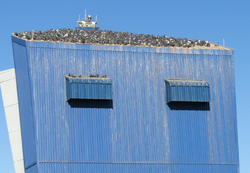
by Alex A. Kecskes
Pigeons have been both friend and foe to mankind for centuries. They have inspired poets and saved lives in wartime. But when they gather in great numbers in cities and towns, they can be most unwelcome. As a pest bird, they can also be most prolific. A single pair of pigeons can produce as many as 18 new pigeons every year--it only takes 19 days for a pigeon egg to hatch baby pigeons.
Then, there are the droppings. One pigeon can generate up to 25 pounds of droppings every year, droppings that attract parasitic insects and flies. Droppings that can spread over 60 transmittable diseases to people and animals. According researchers of the Albert Einstein College of Medicine in New York, pigeon droppings can expose children to Cryptococcus Neoforman fungus. This is airborne fungus grows in rotting pigeon roots, and is present in pigeon droppings. The first step in controlling pigeon droppings is more effective pigeon control.
Aside from disease, the highly acidic nature of pigeon droppings can destroy metal, paint and roofs. In fact, droppings and nests can present property owners with an ongoing repair bills to cover damages to gutters, shingles, AC units, skylights, and dish antennas.
Thankfully, there are a number of highly effective pigeon control products currently available. Most are designed to discourage pigeons from landing and roosting. Moreover, these products have been carefully designed to avoid harming birds, animals and people.
Pigeons have been both friend and foe to mankind for centuries. They have inspired poets and saved lives in wartime. But when they gather in great numbers in cities and towns, they can be most unwelcome. As a pest bird, they can also be most prolific. A single pair of pigeons can produce as many as 18 new pigeons every year--it only takes 19 days for a pigeon egg to hatch baby pigeons.
Then, there are the droppings. One pigeon can generate up to 25 pounds of droppings every year, droppings that attract parasitic insects and flies. Droppings that can spread over 60 transmittable diseases to people and animals. According researchers of the Albert Einstein College of Medicine in New York, pigeon droppings can expose children to Cryptococcus Neoforman fungus. This is airborne fungus grows in rotting pigeon roots, and is present in pigeon droppings. The first step in controlling pigeon droppings is more effective pigeon control.
Aside from disease, the highly acidic nature of pigeon droppings can destroy metal, paint and roofs. In fact, droppings and nests can present property owners with an ongoing repair bills to cover damages to gutters, shingles, AC units, skylights, and dish antennas.
Thankfully, there are a number of highly effective pigeon control products currently available. Most are designed to discourage pigeons from landing and roosting. Moreover, these products have been carefully designed to avoid harming birds, animals and people.
 RSS Feed
RSS Feed